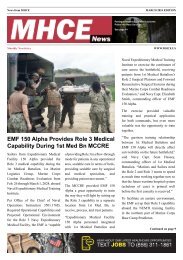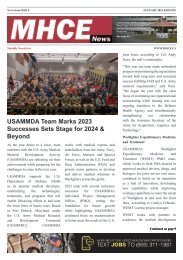MHCE September 2019 Publication
MHCE September 2019 Publication
MHCE September 2019 Publication
Create successful ePaper yourself
Turn your PDF publications into a flip-book with our unique Google optimized e-Paper software.
SEPTEMBER <strong>2019</strong> EDITION<br />
NEWS FROM <strong>MHCE</strong> I WWW.<strong>MHCE</strong>.US<br />
Tucson<br />
Change Hands<br />
Following a<br />
a successful<br />
deployment.<br />
Photo by Petty<br />
Officer 2nd Class<br />
Michael B. Zingaro<br />
Commander.<br />
<strong>MHCE</strong> News<br />
Page 7<br />
Dedication<br />
and<br />
Courage.<br />
Coalition soldiers<br />
enable partner<br />
force commandos<br />
through training.<br />
Page 6 Page 15<br />
NMCP<br />
Recognizes<br />
National Midwifery<br />
Week. Photo By<br />
Petty Officer 1st<br />
Class Laura Myers.<br />
MASS<br />
CASUALTY<br />
Story by Lt. Col. Cynthia King<br />
30th Armored Brigade Combat<br />
Team<br />
WANT TO TAKE<br />
OUT A AD?<br />
SEND AN EMAIL TO<br />
CONTACT@<strong>MHCE</strong>.US<br />
FOR MORE INFO.<br />
MASS CASUALTY EXERCISE<br />
Immediately after the radio call<br />
came into their Troop Medical<br />
Clinic with a report of an accident,<br />
combat medics from the<br />
30th Armored Brigade Combat<br />
Team donned their gear and<br />
departed in three Field Litter<br />
Ambulances (FLAs). While<br />
they knew the call was part of<br />
a training exercise, they didn’t<br />
know what they would encounter<br />
when they arrived at<br />
the mock crash scene outside<br />
of Fort Bliss, Texas, <strong>September</strong><br />
3, <strong>2019</strong>.<br />
U.S. Army Combat Medic Soldiers in the 30th Armored Brigade Combat Team (ABCT), participate in a Mass Casualty (MAS-<br />
CAL) training exercise with the 5th Armored Brigade, First Army Division West, near Fort Bliss, Texas. (U.S. Army National<br />
Guard photo by Sgt. Devin Lewis)<br />
This night-time Mass Casualty<br />
(MASCAL) exercise was<br />
planned between the 30th Armored<br />
Brigade Combat Team<br />
and 5th Armored Brigade,<br />
First Army Division West, to<br />
test the skills of combat medics<br />
responding to a simulated bus<br />
crash with multiple casualties<br />
ejected from the vehicle on a<br />
remote dirt road.<br />
“Once the medics arrived, they<br />
began the process of triage,”<br />
said U.S. Army Sgt. First Class<br />
Meredith Kiser, the 30th Armored<br />
Brigade Combat Team’s<br />
Medical Non-Commissioned<br />
Officer in Charge (NCOIC). “As<br />
EMTs, we refer to it as the ‘golden<br />
hour’ when we stay with<br />
the patients, treat them and<br />
have them evacuated within<br />
an hour.”<br />
U.S. Army Cpt. William Faulk,<br />
a commander in the 5th Armored<br />
Brigade, First Army<br />
Division West, was acting in<br />
both the role of a casualty and<br />
an Observer-Controller Trainer<br />
(OCT) for the exercise. The<br />
other four simulated casualties<br />
were training mannikins with<br />
notional injuries.<br />
“As an OCT, I’m going to be evaluating<br />
how they respond to my<br />
injuries, if they talked to me,<br />
and even if they check my dog<br />
tags to see if I have any medical<br />
allergies,” said Faulk. “By playing<br />
a casualty, I’m right there<br />
and can observe first-hand and<br />
hear everything that they are<br />
doing.”<br />
Kiser said that the two battalions<br />
from the 30th Armored<br />
Brigade Combat Team who responded<br />
to the simulated crash<br />
scene were the 4-118th Combined<br />
Arms Battalion from the<br />
South Carolina Army National<br />
Guard, and the 1-145 Combined<br />
Arms Battalion from the Ohio<br />
Army National Guard.<br />
“The live patient needed treatment<br />
for an open head wound,<br />
where you could see his skull<br />
and he had a piece of metal<br />
sticking out of his thigh, along<br />
with a sucking chest wound,”<br />
said Kiser. “He was labeled urgent-surgical,<br />
so he was the one<br />
we had to call for MEDEVAC<br />
(Medical Evacuation).”<br />
When the UH-60 Black Hawk<br />
MEDEVAC helicopter from the<br />
5th Armored Brigade arrived<br />
on scene, it performed what is<br />
called a dustoff, as the combat<br />
medics carefully loaded Faulk<br />
on the gurney onto the helicopter,<br />
with the rotors whirling<br />
overhead. The other mannikin<br />
patients were loaded onto<br />
the three FLAs. From the time<br />
the combat medics arrived on<br />
scene to the point all patients<br />
were triaged, treated and transported,<br />
was fifty-eight minutes,<br />
according to Kiser.<br />
“These were two teams who<br />
had never worked together<br />
before on an exercise like this,”<br />
said Kiser. “The feedback from<br />
5th Armored Division was<br />
that this was one of the better<br />
groups they’ve observed and<br />
the fastest response time of<br />
other units they’ve observed in<br />
training.”<br />
Kiser added that the value in<br />
the MASCAL exercise also assisted<br />
the 5th Armored Division,<br />
as once they completed<br />
the response portion with the<br />
30th Armored Brigade Combat<br />
Team, they went on to complete<br />
their own training tasks.<br />
“5th Armor was able to use this<br />
exercise for training on their<br />
end, including accepting the<br />
patient, calling it into range operations,<br />
and finishing out the<br />
scenario,” said Kiser. “It was a<br />
great exercise that benefited all<br />
of us.”<br />
The 30th Armored Brigade<br />
Combat team is headquartered<br />
with the North Carolina Army<br />
National Guard and comprised<br />
of units from the South Carolina,<br />
Ohio and West Virginia National<br />
Guard. The Soldiers are<br />
mobilized to support Operation<br />
Spartan Shield in the Middle<br />
East.<br />
CHECK US OUT @ WWW.FACEBOOK.COM/<strong>MHCE</strong>NEWS
2<br />
<strong>MHCE</strong> News<br />
SEPTEMBER <strong>2019</strong> EDITION<br />
IDF OFFICERS<br />
PARTICIPATE IN<br />
TAGLIT-BIRTHRIGHT<br />
ISRAEL VISIT TO<br />
WEST POINT<br />
WEST POINT, NY, UNITED STATES<br />
Story by Michelle Schneider<br />
United States Military Academy at West Point<br />
The U.S. Military Academy had the honor<br />
and privilege of hosting nine Israeli Defense<br />
Forces officers during their first visit to North<br />
America Monday with Taglit-Birthright Israel.<br />
Taglit is the Hebrew word for discovery, and<br />
it was a day of many new experiences for<br />
the IDF officers. Cadets from West Point have<br />
visited Israel through Taglit-Birthright Israel’s<br />
program, but it was the first time in the nonprofit’s<br />
history IDF officers have visited North<br />
America in what they call a reverse-encounter.<br />
Taglit-Birthright Israel is an international<br />
nonprofit that started in 1999 and hosts Jewish<br />
students from all throughout the world.<br />
The goal of the organization is to immerse<br />
people into the Israeli culture and way of life<br />
while building friendships.<br />
Orifa Bino, the director of Mifgashim, the Hebrew<br />
word for Encounter, helped oversee the<br />
events that took place during the IDF officers’<br />
10-day tour in the United States. The purpose<br />
of their visit to West Point was to engage in<br />
learning opportunities and build cross-cultural<br />
relationships.<br />
“They are learning about America not only<br />
from the Jewish perspective, but all perspectives,”<br />
Bino said. “I want them to learn and to<br />
know their similarities to Americans and to<br />
know the other Army’s ways through listening<br />
to the cadets.”<br />
Several representatives from Taglit-Birthright<br />
Israel, West Point personnel, Jewish cadets<br />
and the IDF officers met in the morning and<br />
learned about the history of the academy as<br />
they walked around campus.<br />
They eventually regrouped at a foreign language<br />
classroom in Washington Hall where<br />
a map of Israel was projected onto a screen.<br />
The IDF officers introduced themselves and<br />
pointed to the areas they are from. They<br />
shared their names, ranks and background<br />
and some cadets practiced their Hebrew by<br />
doing the same.<br />
As the day progressed, the IDF officers had<br />
the unexpected opportunity to learn about<br />
the United States Army during Branch Week,<br />
a time of year when representatives from different<br />
career fields set up static displays to<br />
help cadets determine their future Army careers<br />
at Diagonal Walk on The Plain.<br />
“It’s serendipity that they have those booths<br />
and different tents because they show all of<br />
the different parts of the military,” Taglit-Birthright<br />
Program manager of North America<br />
Andrew Kasdan said. “Each of those static<br />
displays spoke to people based upon commonality,<br />
whether it was intelligence, paratroopers<br />
or something else.”<br />
The heart of the IDF officers’ reverse-encounter<br />
trip was to strengthen the bonds between<br />
Israel and the United States by developing<br />
friendships with Jewish cadets at West Point.<br />
Class of 2021 Cadet Max Weisman is a member<br />
of the Jewish choir, chapel and a participant<br />
of Taglit-Birthright Israel in 2016.<br />
“It was an incredible experience to see their<br />
culture, how their military works and all the<br />
things that make us alike and different, but at<br />
the end of the day it’s really cool to see how<br />
similar we all are,” Weisman said. “Today,<br />
they can do the same and see how we operate.<br />
We are great allies with Israel and work<br />
with them, and we will probably continue to<br />
work with them for a long period of time.”<br />
After touring Branch Week, the Israeli officers<br />
and West Point cadets were led by Chaplain<br />
David Ruderman to the West Point Cemetery<br />
where they viewed Col. David “Mickey” Marcus’s<br />
grave.<br />
He was an American Jew and West Point<br />
graduate widely credited for helping Israel<br />
gain independence during the Arab-Israel<br />
War of 1948. They visited his grave to honor<br />
his contribution, dedication and sense of<br />
volunteerism.<br />
The day ended at the grave of Col. Marcus<br />
where IDF officers saluted his tombstone before<br />
parting ways with the cadets to continue<br />
their journey of discovery in North America.<br />
“I want to see the budding of individual personal<br />
relationships and for our cadets and<br />
visitors to share some mutual understandings<br />
about military service,” Ruderman said.<br />
“Our countries and militaries share many<br />
values, so it makes sense for us to get together<br />
and build these relationships.”
WWW.<strong>MHCE</strong>.US <strong>MHCE</strong> News 3<br />
ELLSWORTH GETS A<br />
TASTE OF LATIN AMERICA<br />
ELLSWORTH AIR FORCE BASE, SD,<br />
UNITED STATES<br />
Story by Airman 1st Class<br />
Christina Bennett<br />
28th Bomb Wing Public Affairs<br />
The Ellsworth Latin American Community<br />
(ELAC) hosted a ‘Taste of Latin<br />
America’ food tasting event at the<br />
Base Exchange food court on Sept. 16.<br />
The event was held in observance of<br />
National Hispanic Heritage Month,<br />
which is observed from Sept. 15<br />
through Oct. 15, in recognition of the<br />
many cultures, contributions and accomplishments<br />
of Latin and Hispanic<br />
American people.<br />
Airmen were invited to taste authentic<br />
dishes from Cuba, Colombia, Mexico<br />
and Puerto Rico. They were also<br />
given a brief synopsis of what Hispanic<br />
Heritage Month represents.<br />
Maj. Jose Crespo, the 28th Logistics<br />
Readiness Squadron commander,<br />
provided the opening remarks.<br />
Crespo spoke of accomplishments<br />
achieved by Latin American service<br />
members throughout history, as well<br />
as the rich and diverse cultures of<br />
countries throughout Mexico, Spain,<br />
the Caribbean, and Central and South<br />
America.<br />
In addition to the food tasting event,<br />
the ELAC is scheduled to host a Piñata<br />
Party on Oct. 4 and an ELAC Harvest<br />
Bash on Oct. 11. Both events are set to<br />
be held at the Installation Deployment<br />
Readiness Center on base.<br />
For more information about events<br />
happening during Hispanic Heritage<br />
Month, please contact Staff Sgt. Luis<br />
Soto, the ELAC president, at (605)<br />
386-2887.
4<br />
<strong>MHCE</strong> News<br />
SEPTEMBER <strong>2019</strong> EDITION<br />
SUICIDE PREVENTION:<br />
TALKING ABOUT IT IS<br />
THE HARD PART<br />
Dial 0434+30+extension (last four)<br />
Airman Family Readiness Center DSN 632-5407<br />
ChapelDSN 632-5211<br />
Command Post DSN 632-3100<br />
Family Advocacy 632-5677<br />
Law Enforcement Desk DSN 632-7200<br />
Mental Health DSN 632-5321<br />
Sexual Assault Response Coordinator DSN 632-7272<br />
Dial 911 for on-base emergencies (0434-30-8911 if calling from a commercial line)<br />
Off Base Emergency Commercial 112 for Carabinieri, Fire Department and Medical<br />
National Suicide Prevention and Military Crisis Line-Europe<br />
DSN 118 or 00800-1273-TALK (8255)<br />
Photo By Airman 1st Class Ericka Woolever | U.S Air Force Senior Airman Mason R.<br />
Cardounel, 31st Aircraft Maintenance Squadron, 56th Helicopter Maintenance Unit<br />
electronic warfare journeyman, looks out a window, Sept. 11, <strong>2019</strong>, at Aviano Air Base,<br />
Italy. (U.S. Air Force photo by Airman 1st Class Ericka A. Woolever).<br />
National Suicide Prevention Hotline<br />
1-800-273-TALK (8255)<br />
Military One Source<br />
PORDENONE, ITALY<br />
Story by Airman 1st Class<br />
Ericka Woolever<br />
31st Fighter Wing Public Affairs<br />
Death leaves a heartache that is often difficult<br />
to heal from, because it can be tough<br />
to forget someone who gave so much to<br />
remember.<br />
“I think about him somewhat regularly,<br />
even to this day,” said Senior Airman<br />
Mason R. Cardounel, 31st Aircraft Maintenance<br />
Squadron, 56th Helicopter Maintenance<br />
Unit electronic warfare journeyman.<br />
“I think about what I could have<br />
done better; how I could’ve been a better<br />
friend and confidant.”<br />
Cardounel knew his best friend since<br />
freshman year of high school. They<br />
formed a bond over the movie “Black<br />
Hawk Down” and their shared dream of<br />
joining the military together.<br />
For two best friends, an ordinary day in<br />
high school turned into a day that Cardounel<br />
would never forget.<br />
“It was towards the end of the school<br />
year,” Cardounel said. “I was driving<br />
home from school when I got a call from<br />
my mom. She asked if I talked to him and<br />
I said I talked to him at school.”<br />
Later that day, Cardounel received a<br />
phone call that would change his life forever.<br />
There was a stillness in the room as Cardounel<br />
recalled that day, his tone somber<br />
as he tried to convey his memories into<br />
words.<br />
“I asked her what was going on,” said<br />
Cardounel. “She said his parents hadn’t<br />
heard from him, which I thought was<br />
weird, but maybe he walked home from<br />
school. Maybe he stopped somewhere, or<br />
forgot to tell someone where he was going.<br />
I didn’t really think too much of it at<br />
the time.”<br />
“A few hours later, no one had heard from<br />
him,” said Cardounel. “His parents came<br />
home that night, and that’s when they<br />
found him.”<br />
The Calendar Year 2017 Defense Suicide<br />
Prevention Office Suicide Event Report<br />
indicated the suicide-mortality rate<br />
for Active Duty in 2017, combined across<br />
all Military Services, was 21.9 deaths for<br />
every 100,000 people.<br />
The DoD Leader Guide and Postvention<br />
Checklist provides information and<br />
tools to help individuals gain suicide<br />
awareness.<br />
“Learning about suicide, depression<br />
and how to support others helped me,”<br />
said Cardounel. “I was always the person<br />
that held things in, but now I open<br />
up and talk about how I feel because it<br />
works and makes me feel better.”<br />
People investing their time to build trust<br />
is a way to deliberately care for, support,<br />
and connect with one another.<br />
“The big thing is trust,” said Cardounel.<br />
“That’s the most important thing as far<br />
as preventing suicide. When you put<br />
your trust in someone else and they see<br />
it, you can gain their trust in return.”<br />
Trust begins with conversations, and<br />
knowing there are people, organizations<br />
and other resources available to help;<br />
such as the Airman & Family Readiness<br />
Center, the base chapel, Family Advocacy<br />
and the National Suicide Prevention<br />
Hotline.<br />
“Talking to someone about suicide or<br />
depression is not showing weakness,”<br />
Cardounel said. “If anything, you’re<br />
showing your strength because talking<br />
about it is the hard part.”<br />
If you need to reach out to someone<br />
please reach out to the numbers below:<br />
(Calling from a commercial line)<br />
Dial 0434+30+extension (last four)<br />
Airman Family Readiness Center<br />
DSN 632-5407<br />
Chapel
WWW.<strong>MHCE</strong>.US <strong>MHCE</strong> News 5<br />
STARBASE: CONNECTICUT NATIONAL<br />
GUARD, CIVIL AIR PATROL TEAM UP<br />
WITH JUMOKE ACADEMY<br />
Photo By 1st Lt. Jennifer Pierce | Students and faculty of the Jumoke SMaRT Academy pose after the signing of the memorandum<br />
of understanding with the Starbase program, Connecticut National Guard, and Civil Air Patrol Sept. 19, <strong>2019</strong> in<br />
Hartford, Conn<br />
HARTFORD, CT, UNITED STATES<br />
Story by 1st Lt. Jennifer Pierce<br />
103rd Airlift Wing, Public Affairs,<br />
Bradley Air National Guard Base<br />
HARTFORD, Conn. -- Hartford Mayor<br />
Luke Bronin joined Maj. Gen. Francis<br />
Evon, The Adjutant General of the<br />
Connecticut National Guard, and others<br />
at the Jumoke SMaRT Academy<br />
for the signing of a memorandum of<br />
understanding (MOU) between the<br />
charter school and the Starbase Program<br />
Sept. 19, <strong>2019</strong> in Hartford, Conn.<br />
Starbase is a STEM program, federally<br />
funded through the National Guard,<br />
which primarily targets fifth and sixth<br />
grade students, Ted Garner, director<br />
of Starbase-CT said.<br />
“The goal is to bring the kids in and<br />
get them super excited about STEM<br />
using an immersive classroom experience.<br />
We are putting them through<br />
CAD software, chemistry, physics, robotics,<br />
programming; providing very<br />
hands-on, student<br />
centered learning,” said Garner.<br />
Prior to signing the MOU, Mayor<br />
Bronin addressed the Jumoke students<br />
and faculty members about the<br />
importance of initiating the Starbase<br />
program in Hartford schools.<br />
“STEM opens up so many doors for<br />
our students, and we’ve got some incredibly<br />
talented kids,” said Bronin.<br />
“I’m grateful and excited that they<br />
have the opportunity to not just partner<br />
with the National Guard, but to be<br />
able to explore science, technology, engineering<br />
and math, and discover how<br />
exciting that can be for their future.”<br />
This particular signing also signifies<br />
a new partnership between Starbase<br />
and the Civil Air Patrol, the Air Force<br />
auxillary. This new program will be<br />
implemented in certain schools this<br />
Fall, said Garner.<br />
“About eight schools are participating<br />
in the Starbase program with the Civil<br />
Air Patrol, which we are referring<br />
to as the 2.0 program. We hope this<br />
program proliferates and grows, and<br />
we can begin implementing it in more<br />
schools in the Spring,” Garner said.<br />
“Overall, the Starbase program has<br />
seen significant results when implemented<br />
within schools,” said Garner.<br />
“There is an increased interest level in<br />
STEM, we see student’s growth in critical<br />
thinking skills, their abilities, and<br />
self-confidence. As an organization,<br />
Starbase has seen scholars move on to<br />
earn degrees in science and engineering,<br />
and begin working in STEM related<br />
industries.”
6<br />
<strong>MHCE</strong> News<br />
SEPTEMBER <strong>2019</strong> EDITION<br />
DEDICATION AND COURAGE :<br />
COALITION SOLDIERS ENABLE<br />
PARTNER FORCE COMMANDOS<br />
THROUGH TRAINING<br />
LSYRIA<br />
Story by Spc. Alec<br />
Dionne<br />
Combined Joint Task<br />
Force - Operation Inherent<br />
Resolve<br />
Dedication and Courage:<br />
Coalition soldiers<br />
enable Partner Force<br />
commandos through<br />
training<br />
By Spc. Alec Dionne<br />
(Southwest Asia) –<br />
Armed riflemen line<br />
up outside the house as<br />
the sun crests through<br />
the burned-out buildings.<br />
They approach<br />
the stone entrance,<br />
which is scoured black<br />
by Daesh’s attempted<br />
scorched earth retreat.<br />
Then men enter the<br />
house, kicking down<br />
the door, and, with disciplined<br />
fluidity, storm the<br />
rooms. These are Syrian<br />
Democratic Force (SDF)<br />
commando cadets, undergoing<br />
training from<br />
Coalition trainers.<br />
The Coalition against<br />
Daesh has been providing<br />
training to SDF<br />
commando cadets<br />
throughout a <strong>2019</strong> summer<br />
training cycle. The<br />
resolve of the SDF to remove<br />
violent extremism<br />
from their homeland has<br />
remained strong since<br />
the rise of Daesh.<br />
“This training will challenge<br />
your mind and<br />
your body”, said a Coalition<br />
instructor while<br />
giving feedback during<br />
training. “It will teach<br />
you how to fight well under<br />
stressful conditions”,<br />
he added.<br />
The SDF is an alliance<br />
of local fighters who<br />
hail from many backgrounds.<br />
The Coalition’s<br />
training contributes<br />
directly to the enduring<br />
defeat of Daesh by<br />
training a lethal Partner<br />
Force that can keep the<br />
river valley clear of violent<br />
extremists.<br />
In a combat situation you<br />
will be hungry, thirsty<br />
and tired, preaches one<br />
Coalition trainer to the<br />
commando cadets before<br />
a live fire exercise.<br />
“On a lot of missions you<br />
will get tired and it will<br />
go to your head, but we<br />
want you to be able to<br />
calm yourself down and<br />
shoot accurately.”<br />
Initial storming of the<br />
burned-out houses<br />
starts slowly. Instructors<br />
begin by teaching the<br />
cadets room-by-room.<br />
As with any learning<br />
process, there are mistakes,<br />
and moments of<br />
frustration, but the commando<br />
cadets do not<br />
appear discouraged. As<br />
a result, the commando<br />
cadets are ready to try<br />
a house on their own the<br />
end of the morning.<br />
As the cadets progress,<br />
feedback from the coalition<br />
trainers keeps them<br />
motivated to improve despite<br />
setbacks.<br />
The commando cadet<br />
team makes their final<br />
approach in through<br />
the hallway, as dark figures.<br />
The door to the<br />
apartment bursts open<br />
as they enter and the cadets<br />
rush in. In seconds,<br />
they eliminate their targets,<br />
and the rooms are<br />
secure. Their hard work<br />
has paid off, and they<br />
exit the day’s training<br />
proficient in their combat<br />
drills, one step closer<br />
to graduating as realized<br />
commandos.<br />
They will be back early<br />
tomorrow for more, for<br />
another class with their<br />
Coalition trainers.
WWW.<strong>MHCE</strong>.US <strong>MHCE</strong> News 7<br />
TUCSON CHANGES HANDS<br />
FOLLOWING A SUCCESSFUL<br />
DEPLOYMENT<br />
Photo By Petty Officer 2nd Class Michael B Zingaro | JOINT BASE PEARL HARBOR-HICKAM (Sept. 20,<br />
<strong>2019</strong>) -- Cmdr. Chad Hardt, from Aiken, South Carolina, salutes the ensign during a change of command<br />
ceremony for the Los Angeles-class fast-attack submarine USS Tucson (SSN 770) on the submarine<br />
piers, Sept. 20. Cmdr. Douglas Pratt, from Nashua, New Hampshire, relieved Hardt as Tucson’s commanding<br />
officer.<br />
PEARL HARBOR, HI, UNITED<br />
STATES<br />
Story by Petty Officer 2nd Class<br />
Michael B Zingaro<br />
Commander Submarine Forces<br />
Pacific<br />
PEARL HARBOR, Hawaii (NNS)<br />
— The Los Angeles-class fast-attack<br />
submarine USS Tucson<br />
(SSN 770) held a change of<br />
command ceremony, pier side<br />
at Joint Base Pearl Harbor-Hickam,<br />
Hawaii, Sept. 20.<br />
Cmdr. Douglas Pratt, from Nashua,<br />
New Hampshire, relieved<br />
Cmdr. Chad Hardt, from Aiken,<br />
South Carolina, and assumed<br />
the duties and responsibilities<br />
of the commanding officer following<br />
the successful completion<br />
of a Western Pacific deployment.<br />
“The crew of Tucson performed<br />
admirably through a<br />
wide-range of submarine operations<br />
during this extended<br />
seven-month deployment,” said<br />
Hardt. “These Sailors formed a<br />
cohesive team that rose to the<br />
challenge on every occasion,<br />
enabling the ship to execute exceptionally<br />
well. I am extremely<br />
proud to be associated with this<br />
group of submariners — they<br />
were fantastic representatives<br />
of the city of Tucson, the Navy,<br />
and the United States.”<br />
Rear Adm. Jimmy Pitts, commander,<br />
Submarine Group 7,<br />
was the guest speaker of the<br />
ceremony, which was attended<br />
by distinguished visitors, family,<br />
friends, and crew.<br />
“The importance of our submarine<br />
force for the security and<br />
stability of the Indo-Pacific cannot<br />
be overstated, starting with<br />
World War II, continuing in the<br />
Cold War, and throughout the<br />
subsequent decades of peace<br />
and prosperity across this vital<br />
region of the world,” said Pitts.<br />
“This was most recently evident<br />
by Tucson’s significant contributions<br />
to 7th Fleet high priority<br />
warfighting objectives during<br />
a Western Pacific deployment.”<br />
Since Tucson’s departure in<br />
February, they completed six<br />
port visits in the 7th Fleet area<br />
of operations, which enhanced<br />
and strengthened relationships<br />
with allies and partners. Also,<br />
17 crew members advanced<br />
to the next pay grade, 13 reenlisted,<br />
and 22 crew members<br />
earned their submarine warfare<br />
qualifications.<br />
“Our crew ethos is, ‘we are professionals,<br />
we are family, and<br />
we are warriors.’ Combat readiness<br />
and battle-mindedness<br />
were themes that were pervasive<br />
both during the training<br />
and workup to deployment, as<br />
well as throughout execution.<br />
We consistently viewed our<br />
operations through the lens of<br />
readiness for future combat<br />
and ensured that our Sailors<br />
did as well,” said Hardt.<br />
Hardt’s next assignment will be<br />
on the staff of Commander, Submarine<br />
Force, U.S. Pacific Fleet.<br />
Pratt previously served on the<br />
staff of Commander, Submarine<br />
Squadron 21, based out of Naval<br />
Support Activity, Bahrain.<br />
“The crew you see assembled<br />
here are some of the finest Sailors<br />
I’ve ever seen,” said Pratt. “It<br />
amazes me how much talent is<br />
onboard. Every day you remind<br />
me why the United States Navy’s<br />
submarine force is so great.<br />
I am honored and excited to<br />
have the opportunity to be your<br />
captain.”<br />
Tucson’s return to Pearl Harbor<br />
marks the completion of<br />
five deployments since the last<br />
major overhaul period, and 11<br />
total deployments completed<br />
since its commissioning on <strong>September</strong><br />
9, 1995. Tucson is the<br />
second ship of the U.S. Navy to<br />
be named for the Arizona city.<br />
It is the 59th Los Angeles-class<br />
fast-attack submarine and the<br />
20th of the improved Los Angeles-class<br />
fast-attack submarines<br />
to be built. Twelve vertical-launch<br />
missile tubes for<br />
Tomahawk cruise missiles provide<br />
Tucson with great offensive<br />
capability. Retractable bow<br />
planes give the ship increased<br />
maneuverability and under ice<br />
surfacing potential.<br />
For more new from the Pacific<br />
Submarine Force, visit<br />
www.csp.navy.mil.
8<br />
<strong>MHCE</strong> News<br />
AUGUST <strong>2019</strong> EDITION<br />
Centurion contracts with state and county government agencies<br />
nationwide to provide medical, mental health, and dental services<br />
to a variety of patient settings including correctional facilities,<br />
state hospitals, and community health centers. Our dedication<br />
to making a difference and our passionate team of exceptional<br />
healthcare employees have made Centurion one of the leaders in<br />
the industry. We are proud to be a trusted partner to government<br />
agencies in 16 states. Correctional facilities have become a critical<br />
setting in providing the opportunity to greatly impact and<br />
improve public health by providing comprehensive prevention,<br />
screenings, and treatment of diseases and mental health illnesses.<br />
Chronic and infectious diseases and mental health illnesses<br />
are more prevalent in jail and prison inmates than the general,<br />
non-institutionalized population. By joining Centurion, you will<br />
have the unique opportunity to make a positive impact on not<br />
only the patients, but also on the communities to which they return.<br />
The average incarceration time is almost three years and a<br />
third of the country’s incarcerated population is in jails. You can<br />
track progress and follow up with patients more than you ever<br />
could in other settings because compliance with treatment and<br />
medication is required. Let us show you the way to an exciting<br />
and rewarding career in correctional healthcare. Here you can<br />
guide the delivery of services to a diverse population of patients<br />
and have a positive impact on public health. Enjoy an innovative,<br />
team-oriented atmosphere free of administrative hassles often<br />
found in other healthcare settings. Visit www.teamcenturion to<br />
learn more, or email us at recruiting@teamcenturion.com
WWW.<strong>MHCE</strong>.US <strong>MHCE</strong> News 9
10<br />
<strong>MHCE</strong> News<br />
AUGUST <strong>2019</strong> EDITION<br />
FORMER PRISONER OF WAR<br />
REFLECTS ON CAPTURE<br />
worked out very well for me and my<br />
family.”<br />
Camerota continued his career in aviation,<br />
eventually spending his last assignment<br />
as a C-21A pilot instructor<br />
pilot, mission coordination and safety<br />
officer with the 58th Military Airlift<br />
Squadron at Ramstein from 1984-1987.<br />
In the U.S., National POW/MIA Recognition<br />
Day is observed on the third Friday in <strong>September</strong>.<br />
It honors those who were prisoners<br />
of war and those who are still missing in<br />
action.<br />
Photo By Senior Airman Milton Hamilton | Retired U.S. Air Force Maj. Pete Camerota<br />
poses for a photo during Prisoner of War/Missing in Action Recognition Week, at<br />
Ramstein Air Base, Germany, <strong>September</strong>, 16, <strong>2019</strong>. Camerota was a Prisoner of War<br />
for 86 days, during the Vietnam War.<br />
RAMSTEIN AIR BASE, RP, GERMANY<br />
Story by Senior Airman Milton Hamilton<br />
86th Airlift Wing/Public Affairs<br />
In honor of Prisoner of War/Missing in<br />
Action Recognition Day, a former prisoner<br />
of war came to Ramstein Air Base,<br />
Sept. 16 to share his experience and visit<br />
one of his last duty stations before he retired.<br />
At the time of becoming a prisoner of<br />
war, retired Maj. Pete Camerota, was<br />
a Captain, assigned to the 22nd Bomb<br />
Squadron, 22nd Bomb Wing, at what<br />
was then designated as March Air Force<br />
Base, California.<br />
Camerota was forced to eject from a B-52<br />
over Vietnam on December 22, 1972.<br />
“My very first thought when my parachute<br />
opened was, oh my God, I’m hanging<br />
in the straps here, and Joy, my wife, is<br />
10,000 miles away from home and she’s<br />
pregnant,” said Camerota.<br />
Camerota then did what he was trained<br />
to do and checked the functionality of his<br />
parachute and looked for place to land.<br />
Camerota evaded his captors for 12 days<br />
before being apprehended, after suffering<br />
from dehydration and malnourishment.<br />
“I absolutely believe the Survival, Evade,<br />
Resistance, and Escape training I went<br />
through was a big help,” said Camerota.<br />
Camerota was held in captivity for 86<br />
days, 16 of those days in solitary confinement,<br />
in the same POW camp as<br />
former Senator John McCain.<br />
Before being placed in solitary confinement,<br />
Camerota was interrogated<br />
constantly and was encouraged to cooperate<br />
to receive a more favorable<br />
treatment.<br />
“In a survival situation you resist as<br />
much as you can without getting yourself<br />
hurt,” said Camerota. “I was already<br />
exhausted and had fallen asleep by accident<br />
during one line of questioning,<br />
then I realized I could feign sleep as a<br />
resistance tool.”<br />
Camerota was released during Operation<br />
Homecoming March 29, 1973, and<br />
was briefly hospitalized to recover from<br />
injuries at March AFB. He received a<br />
Distinguished Flying Cross with Valor<br />
decoration for his courage and selflessness<br />
during his time in Vietnam.<br />
After being released and reunited with<br />
his wife, Camerota was still committed<br />
to service and wanted to go to pilot<br />
training. He credits his wife for being<br />
an amazing support system, allowing<br />
him to stay in the Air Force and pursue<br />
his career goals even though they both<br />
had just gone through a traumatic ordeal.<br />
“My wife’s support was as important<br />
to me as the Air Force was,” said Camerota.<br />
“The Air Force let me do what I<br />
could do. My career path was set and
WWW.<strong>MHCE</strong>.US <strong>MHCE</strong> News 11
12<br />
<strong>MHCE</strong> News<br />
AUGUST <strong>2019</strong> EDITION<br />
ORIENT SHIELD<br />
<strong>2019</strong>, A SOLDIERS<br />
KUMAMOTO, JAPAN<br />
Courtesy Story<br />
Photo By Staff Sgt. Jacob Kohrs<br />
The crew members of the Japan Ground Self-Defense Force Type 12 Surface to Ship Missile System and<br />
the U.S. Army M-142 High Mobility Artillery Rocket System pose for a picture with their vehicles as part<br />
of the Orient Shield <strong>2019</strong> media day, Sept. 17 <strong>2019</strong>, Oyanohara Training Area, Japan.<br />
KUMAMOTO, JAPAN<br />
Courtesy Story<br />
U.S. Army Japan<br />
Camp Kengun, Japan – U.S. Army<br />
and Japan Ground Self-Defense<br />
Force soldiers are learning valuable<br />
lessons from each other<br />
during the bilateral field exercise<br />
Orient Shield 19 in Japan, Sept.<br />
5-24, <strong>2019</strong>. OS 19 is a premier U.S.<br />
Army and JGSDF bilateral field<br />
training exercise that is meant to<br />
increase interoperability by testing<br />
and refining multi-domain<br />
and cross-domain concepts.<br />
“While we have been out here, I<br />
believe that we both have learned<br />
several things about each other’s<br />
systems.” said Staff Sgt. Michael<br />
Graham, M-142 High Mobility Artillery<br />
Rocket System crew chief<br />
from 5th Battalion, 3rd Field Artillery<br />
Regiment, 17th Field Artillery<br />
Brigade.<br />
The systems that Graham is<br />
speaking about are the U.S. Army’s<br />
HIMARS and the JGSDF’s<br />
Type 12 Surface to Ship Missile<br />
system. These units have been<br />
training together to learn what<br />
their tactics, techniques and procedures<br />
are when it comes to<br />
their different capabilities and<br />
operational styles.<br />
“One of the things that I have<br />
learned is that the Japanese are<br />
really good when it comes to<br />
the cover and concealment of<br />
their system,” said Graham. “I<br />
think what they have learned<br />
from us is the efficiency of how<br />
we load and unload our rockets.”<br />
The Illinois Army National<br />
Guard’s 33rd Infantry Brigade<br />
Combat Team also joined in the<br />
training during OS 19 with the<br />
JGSDF’s 4th Division, Western<br />
Army.<br />
“We are out here with the Japanese<br />
showing them how we<br />
run convoys, reacting to contact<br />
and how we conduct ambushes<br />
and recons,” said Spc.<br />
Luis Leyda, an infantry team<br />
leader with the 2nd Squadron,<br />
106th Cavalry Regiment, 33rd<br />
IBCT. “We are doing this in a<br />
crawl, walk, run style of training,<br />
where we go through the<br />
motions of the training with our<br />
Japanese counterparts. Then<br />
when we feel that we all understand<br />
it, we will conduct the live<br />
fire training.”<br />
Leyda goes on to explain that<br />
they have learned some new<br />
procedures about the tactics<br />
that the Japanese employ that<br />
are a little different from the<br />
tactics that U.S. doctrine uses.<br />
These battle drills are not necessarily<br />
better or worse, they<br />
are different, and that’s why OS<br />
19 provides great opportunities<br />
for allies to share several ideas<br />
and methods on battlefield operations.<br />
After two weeks in the field for<br />
both the artillery systems and<br />
the infantry units, both countries<br />
soldiers have learned from<br />
each other while having some<br />
fun in the process.<br />
“It doesn’t have to be mission all<br />
the time,” said Leyda. “Like us,<br />
as infantrymen they have their<br />
own rituals and games that<br />
they go through and play.”<br />
One of the games that the soldiers<br />
all played together was<br />
called the watermelon game.<br />
This is where you have two<br />
teams and the first person is<br />
blindfolded, spun around and<br />
directed to hit a watermelon<br />
with a stick. If they miss, the<br />
next person in line is up. The<br />
first team that smashes the watermelon<br />
wins.<br />
“We are learning as much as<br />
we can out here,” said Leyda.<br />
“Yet they are just like any other<br />
grunt, they are energetic and<br />
loud, just like us and we love it<br />
because that energy on energy<br />
is awesome!”
WWW.<strong>MHCE</strong>.US <strong>MHCE</strong> News 13<br />
NMCSD Women Physicians Recognized at NYC<br />
NEW YORK, NY, UNITED STATES<br />
Photo by Suzanna Brugler<br />
Naval Medical Center San Diego<br />
190727-N-WX378-0211 NEW YORK<br />
(July 27, <strong>2019</strong>) (Left to Right) Lt.<br />
Cmdr. Monica Ormeno, MC, USN,<br />
Naval Medical Center San Diego<br />
(NMCSD) child and adolescent psychiatrist;<br />
retired Rear Adm. Dawn<br />
Wyllie, commissioned corps officer<br />
of the U.S. Public Health Service;<br />
Cmdr. Paulette Cazares, MC, USN,<br />
NMCSD medical clinician; Lt. Cmdr.<br />
Danielle Barnes, MC, USN,<br />
NMCSD pediatrician; and Maj. Carolyn<br />
Salter, MC, USA, pose for a group<br />
photo at the centennial meeting of<br />
the Medical Women’s International<br />
Association (MWIA), an international<br />
group of women physicians.<br />
The meeting was hosted by the<br />
American Medical Women’s Association<br />
(AMWA), a U.S.-based women<br />
physicians’ group, at the Brooklyn<br />
Bridge Marriott.<br />
During the event MWIA recognized<br />
the dual nature of service,<br />
to both their patients and their respective<br />
nations, of eight women<br />
military and veteran physicians.<br />
(U.S. Navy photo by Mass Communication<br />
Specialist 1st Class Bryan<br />
Ilyankoff/RELEASED
14<br />
<strong>MHCE</strong> News<br />
AUGUST <strong>2019</strong> EDITION<br />
30TH ARMORED BRIGADE COMBAT TEAM<br />
CONDUCTS COMBINED ARMS LIVE-FIRE EXERCISE<br />
FT BLISS, TX, UNITED STATES<br />
09.20.<strong>2019</strong><br />
Story by Lt. Col. Cynthia King<br />
30th Armored Brigade Combat Team<br />
Subscribe7<br />
“It demonstrates the firepower, precision,<br />
and lethality of an Armored Brigade<br />
Combat Team,” said U.S. Army Col.<br />
Robert Bumgardner, commander, 30th<br />
Armored Brigade Combat Team, North<br />
Carolina Army National Guard, when<br />
describing the Combined Arms Live-<br />
Fire Exercise (CALFX).<br />
Delta-Troop, 1-150th Cavalry Regiment,<br />
30th Armored Brigade Combat Team,<br />
participated in the CALFX in the vicinity<br />
of Fort Bliss, Texas, Sept. 20, <strong>2019</strong>. Crews<br />
operating the M1A1 Abrams Main Battle<br />
Tank, mortars, and M109 Paladins were<br />
able to exercise their weapons’ capabilities<br />
on one of the largest military training<br />
ranges in the United States.<br />
“We had a tank company in the fight,<br />
with mortars and a field artillery battery<br />
in support,” said Bumgardner. “The<br />
scenario included a passage of lines<br />
through the Scout platoons, moving forward<br />
to destroy the enemy.”<br />
The CALFX was the culminating event<br />
for the unit, as they are mobilized to<br />
support Operation Spartan Shield in the<br />
Middle East. The tank crews had to meet<br />
the table gunnery requirements before<br />
advancing to the complexities of the livefire.<br />
U.S. Army Lt. Col. Clifford Brackman,<br />
commander 1-150th Cavalry Regiment,<br />
30th Armored Brigade Combat Team,<br />
said that the tanks involved in the<br />
CALFX were supported by unit sections<br />
with 125mm mortar fire and 155mm<br />
cannons from field artillery.<br />
“Any chance they have to launch rounds<br />
downrange, they are fired-up,” said<br />
Brackman when describing the morale<br />
of his Soldiers.<br />
Bumgardner equated the importance<br />
of readiness and proficiency of these<br />
crews to how U.S. armored forces performed<br />
during the Persian Gulf War in<br />
1991.<br />
“While technology may have advanced<br />
since the tank battles in the Gulf War,<br />
one thing has never changed and that<br />
is the lethality, physical toughness, and<br />
mental resolve of the U.S. Soldier in combat,”<br />
said Bumgardner.<br />
Brackman said that the training ranges<br />
and facilities at Fort Bliss have been outstanding<br />
for his Soldiers. He added that<br />
they always look forward to any opportunity<br />
to demonstrate their military proficiency<br />
and skills.<br />
“This is how commanders build trust in<br />
their troops,” said Brackman. “We know<br />
these Soldiers are ready for their mission,<br />
and combat.”<br />
The 30th Armored Brigade Combat<br />
Team is comprised of units from the<br />
North Carolina, South Carolina, West<br />
Virginia and Ohio Army National Guard.<br />
They will support Task Force Spartan in<br />
training and working with host nation<br />
partners in the Middle East, to assist<br />
them maintain stability in the region.
WWW.<strong>MHCE</strong>.US <strong>MHCE</strong> News 15<br />
NMCP RECOGNIZES<br />
NATIONAL<br />
MIDWIFERY WEEK<br />
Photo By Petty Officer 1st Class Laura Myers | 181004-N-IY469-016 – An NMCP midwife<br />
talks to Capt. Carolyn Rice, NMCP’s executive officer; Capt. Christopher Culp,<br />
NMCP’s commanding officer, and Capt. Dixie Aune, Director of Nursing Services, during<br />
an appreciation breakfast for National Midwifery Week.<br />
FT. MCCOY, WI, UNITED STATES<br />
Story by Staff Sgt. Amy Picard<br />
4th Combat Camera Squadron<br />
National Midwifery Week was observed<br />
Sept. 30 through Oct. 6. To show appreciation<br />
for Naval Medical Center Portsmouth’s<br />
(NMCP) midwives, Capt. Christopher<br />
Culp, NMCP’s commanding officer;<br />
Capt. Carolyn Rice, NMCP’s executive<br />
officer; and Capt. Dixie Aune, Director of<br />
Nursing Services, provided them breakfast<br />
Oct. 4 before the start of their shift.<br />
Culp expressed his gratitude for their<br />
hard work and dedication to the mission.<br />
“You guys are in a specialty and a practice<br />
that is timeless, as you know,” Culp<br />
said. “You know there’s no Monday<br />
through Friday, 8 to 4 in what you do.<br />
You see long weekends and liberal leave<br />
and all sorts of things that apply to lots of<br />
the command but never apply to you because<br />
your business just never stops<br />
so it’s an added reason to come up<br />
here and tell you thank you for what<br />
you do.”<br />
Rice added her appreciation and<br />
shared a quick personal story of her<br />
experience with midwives.<br />
“I know the history with midwifery,<br />
being a physician, I didn’t get to work<br />
as closely with you, but being a mom<br />
with three kids, my second child was<br />
delivered by a midwife, and I was<br />
lucky enough that she took me on and<br />
my family on,” Rice said. “I appreciate<br />
everything you do and thanks for<br />
giving us a little bit of your time this<br />
morning before you get started.”
16<br />
<strong>MHCE</strong> News<br />
SEPTEMBER <strong>2019</strong> EDITION<br />
CYBER DOMAIN LINKS COMMUNICATION,<br />
IMPROVES PACIFIC REGION READINESS<br />
Photo By Lance Cpl. Ryan Pulliam | U.S. Marine Corps Lance Cpl. Kimberly Ortiz Marrero, a native of Lancaster, N.Y. and the hazardous material and safety representative for<br />
3rd Transportation Support Battalion, stands while being decontaminated during the Hazardous Waste Operations and Emergency Response course at Camp Foster, Okinawa,<br />
Japan, Sept. 19, <strong>2019</strong>. After completing an exercise, all the students who wore hazardous material suits had to undergo a mock-decontamination procedure where they<br />
entered a tent and were sprayed with water.<br />
SAGAMIHARA, KANAGAWA, JAPAN<br />
Story by Sgt. Raquel Villalona<br />
38th Air Defense Artillery Brigade<br />
SAGAMIHARA, Japan – In a U.S. unilateral training exercise,<br />
air defense, fires, aviation and maritime elements<br />
merged proficiencies to enhance readiness in the Pacific<br />
Region.<br />
The 38th Air Defense Artillery Brigade partnered with<br />
17th Field Artillery Brigade, U.S. Army Aviation Battalion-Japan,<br />
and U.S. Navy HSM-51 Maritime Strike<br />
Squadron, aligned communication capabilities through<br />
the use of the Link 16 cyber domain on Sagami General<br />
Depot, Sept. 9-21.<br />
“Link 16 is a joint data communication that provides the<br />
end user with connectivity to other forces,” said Chief<br />
Warrant Officer 2 Keon Ellison, interface control officer,<br />
38th ADA Brigade. “It provides targeting data, air track<br />
data. Basically, it provides input into the common operational<br />
picture or the air picture that allows the unit to<br />
see where everything is and see where other players<br />
are on the battlefield.”<br />
The 17th FAB served as the multi-domain task force<br />
headquarters for the training event.<br />
“Helping operations was the participation of the 38th<br />
ADA Brigade granting access to equipment that we<br />
don’t organically have in the 17th FAB,” said Chief<br />
Warrant Officer 2 Christopher W. Coker, command<br />
and control systems integrator, 17th FAB. “With the<br />
use of Link 16, as well as assets such as the MH-60<br />
(Sea Hawk Helicopters) from the U.S. Navy and UH-<br />
60L (Black Hawk Helicopters) from U.S. Army Aviation<br />
Battalion-Japan, all of those entities coming<br />
together, helped us validate and further test what<br />
we can actually accomplish as a multi-domain task<br />
force.”<br />
Participants sought to increase interoperability and<br />
prove that they could share targeting information<br />
and sensor information to lethal systems and mission<br />
command nodes across the Link 16 network for<br />
commanders to make real-time immediate decisions.<br />
“It takes all the domains: air, cyber, and ground, and<br />
brings them together into one task force,” said Lt.<br />
Col. John Franz, U.S. Army Aviation Battalion-Japan<br />
commander. “The task force commander has multi-domain<br />
assets scattered across the battlefield in a<br />
distributed fashion. The air component provides lethal<br />
fires and reconnaissance to that air domain for<br />
situational awareness and also protects distributed<br />
assets.”<br />
The exercise offered a collaborative approach to<br />
address the complexities of joint operations and enhances<br />
‘Fight Tonight’ unit readiness.<br />
“The training was challenging because when we<br />
talk about joint partners and multi-service operations,<br />
there’s always a little bit of colloquialism that<br />
goes along with that,” said Franz. “We had to break<br />
through some of those barriers, simple things like<br />
frequency exchanges and terminology, to make the<br />
training much more effective.”<br />
Link 16 allows the exchange of voice and data needed<br />
to build a common operating picture and provide<br />
effective mission command.<br />
“Multi-domain operations are about punching a hole<br />
in the enemies defenses to rapidly exploit that hole<br />
and then go back to that defense,” said Franz. “That<br />
helps our partners and allies here in Japan and other<br />
services to be able to bring their assets to the fight<br />
and to be able to conduct operations with the Army<br />
in order to seamlessly show… that we can go attack<br />
the enemy and then go back to the defense.”


















